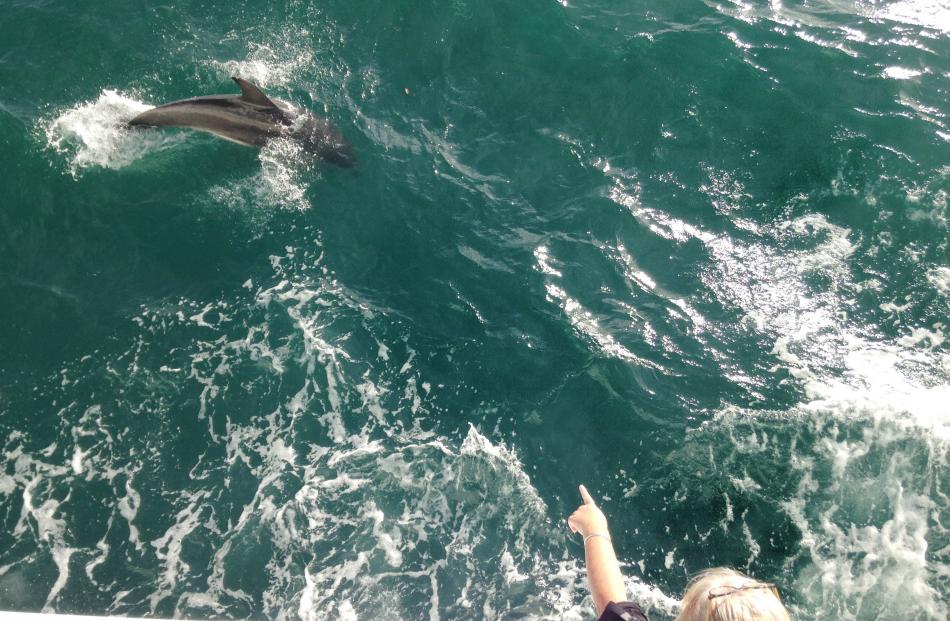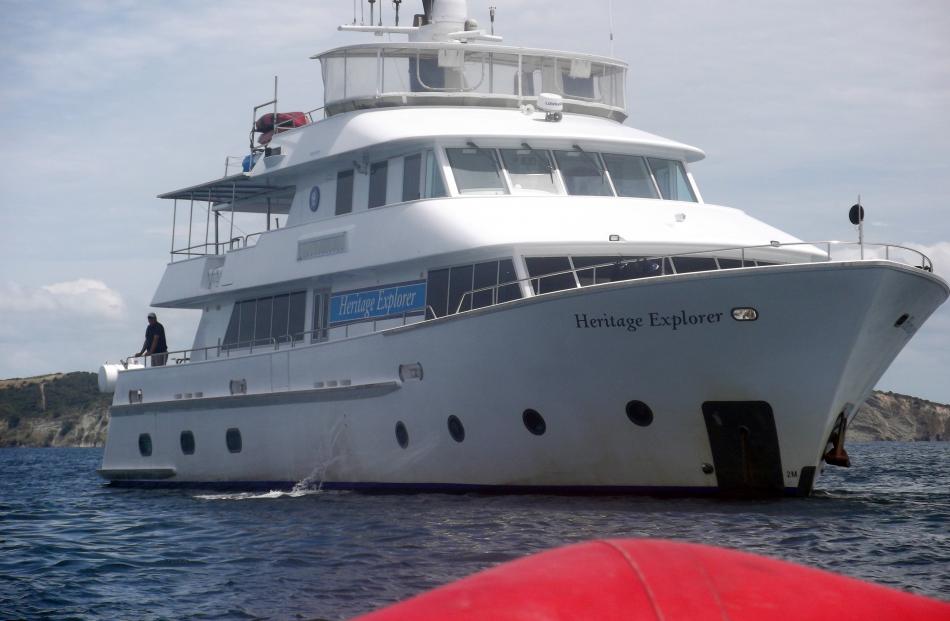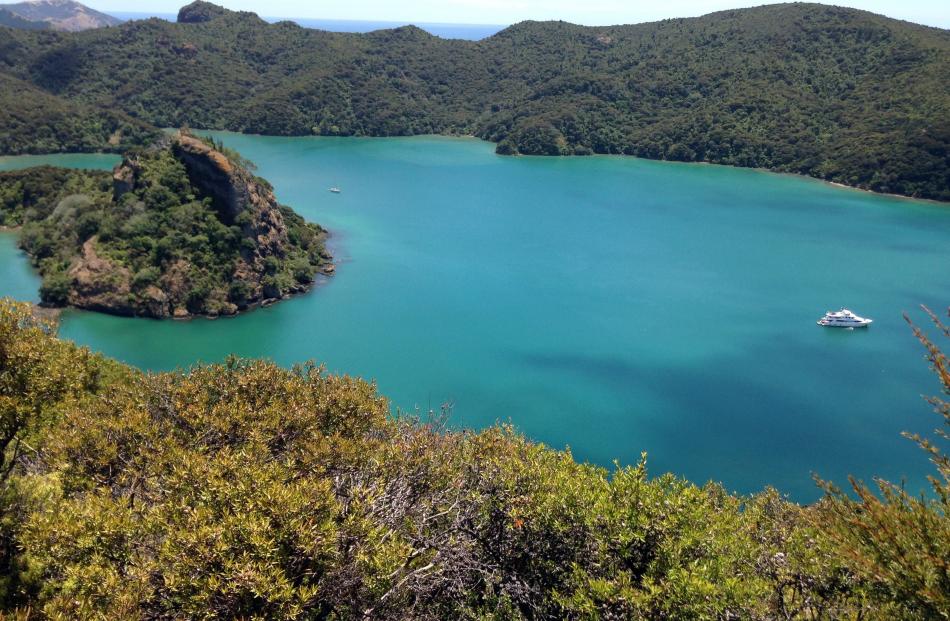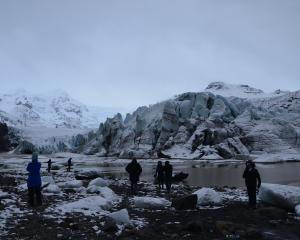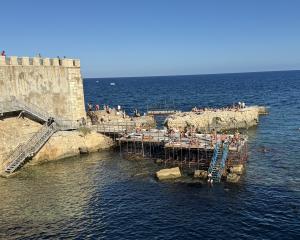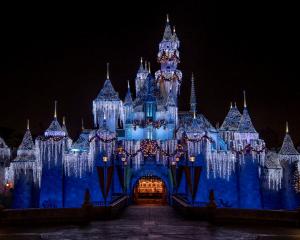Eleanor Hughes sails off to explore New Zealand’s north.
From the Heritage Explorer’s sundeck, I watch Auckland CBD gradually diminish as we cruise eastwards into the Hauraki Gulf, the sun casting a silver sheen across the sea. We pass Rangitoto, Motutapu, Motuihe and Waiheke, where yachts cluster in idyllic inlets. The islands I’ve viewed before by sea, but in the next seven days Heritage Expeditions will take me to places I haven’t been. I’m looking forward to cruising as far east as Great Barrier Island and as far north as Whangaroa Harbour in Northland.
On the itinerary are a number of island sanctuaries. The vessel takes 18 guests, but I’ve got lucky and there’s only nine on this January sailing, so there’s little waiting around for the Zodiac inflatable boats to take us to shore. First stop is Tiritiri Matangi. Over two hours, a volunteer guide has us spotting numerous native birds, including saddleback, kākāriki, takahē and an almost camouflaged morepork. Home to New Zealand’s oldest operating lighthouse, built in 1865, its visitor centre displays the island’s history. From the watchtower, I view gulf islands, Hunua Ranges and the Coromandel Peninsula.
Time on Great Barrier is spent walking the Glenfern Loop in Glenfern Sanctuary, an 83ha regional park accessed from Port Fitzroy. Crossing streams and bridges and climbing numerous steps, we traverse picturesque native forest. Slightly off track, a one-plank-wide suspended bridge leads to a ladder accessing a platform around a 600-year-old kauri. From it, I get a peek of an indigo Port Fitzroy harbour amongst bush-blanketed land. Further on, Sunset Rock gives wider views of the harbour, dotted with yachts and launches.
In the Bay of Islands, I walk three of its predator-free islands; Motorua on our way north and Roberton and Urupukapuka on our return. White sand beaches dazzle; high points give views of some of the 144 islands making up the region, forming a green maze in a mottled blue sea. I’m serenaded by tui, fantail and saddleback on each. On Motorua, which has a gun emplacement and the concrete foundations of a long-gone defence base hut, banded rail run across our path. Roberton Island, where the Endeavour was anchored in 1769, also hosts quail, pūkeko and dotterel. The island’s Māori and early European history is told in metal sculptures and stories. From its lookout, I gaze down on a blue lagoon almost cutting the island in half. In windy, overcast conditions only the brave snorkel in its calm waters, seeing snapper, blue moki and other small fish.
More history is learnt at pōhutukawa-fringed Whangamumu Harbour. In the almost-circular serene bay, I wander amongst the concrete foundations and vats of Whangamumu Whaling Station, operating in the 1800s and early 1900s. A ramp and metal rails still head seawards.
Marsden Cross stands in Rangihou Bay, the site of New Zealand’s first Christian missionary service, held in 1814. There, in the balmy evening, we sit out on deck; brown kiwi calling to each other, breaking the stillness.
Cruising past Mataura Bay, I spot the memorial to the Rainbow Warrior on a hill, the ship towed to and sunk at nearby Cavalli Islands.
There are more historic lighthouses. We would’ve climbed to the 1883 Mokohīnau Islands Lighthouse, on Burgess Island, had it not been too rough for the Zodiac to access the island. Cape Brett Lighthouse, built in 1910, stands at the tip of Cape Brett Peninsula at the southern end of the Bay of Islands where, just off it, we get close to the Hole in the Rock.
Towering basalt domes and mystical rock formations — including a swirling meringue-shaped islet of rock and bush, somewhere mystical beings might inhabit — populate stunning Pekapeka Bay in Whangaroa Harbour. Some Zodiac into the mangroves and along the bay’s shoreline, scattered with baches, while others swim off the boat. Three of us climb the Dukes Nose, scaling an almost vertical rock with the help of a metal pole drilled into the rockface. We look down on turquoise sea, green fingers of land weaving amongst it. A great adventure!
So, too, is visiting the world’s largest sea cave: Rikoriko Cave at Poor Knights Islands. Breaking waves spray us on the Zodiac ride to its entrance, where clear azure water entices us in. The cave opens to a high ceiling patchworked with bluish-green moss and minerals, orange and white. A purplish hue fringes the waterline.
With little time on the entire cruise spent not in sight of land, views are varied. Auckland’s cityscape; uninhabited bush-covered islands; picturesque islets dotting Man of War Passage near the entrance to Port Fitzroy. Further north, waves pound stark cliff coastline interspersed with rolling green hills and distant ranges. White sandy beaches might have a smattering of buildings on their shoreline or an isolated campsite. The protected, tranquil Whangururu Harbour is dotted with small settlements.
When anchored in calm waters, some kayak or fish, although copper sharks seem to keep anything catchable away. Others read on the sundeck or in the lounge. I peruse books in the library on our destinations and the area’s marine life, but our expedition guides provide just as much information. Lyn has a Queen’s Service Medal for her conservation work on Little Barrier, which we skirted on the way to Great Barrier. It was the country’s first nature reserve, becoming so in 1895. North Island brown kiwi populate its dense, primeval forest along with fourteen reptile species, including tuatara. It’s the only known breeding ground for the New Zealand storm petrel, and home to over 400 native plants.
When we spot waterspouts, and then a long, grey whale’s back with a small, black dorsal fin emerges from the sea, Riona, our marine specialist, identifies it as a Bryde’s whale, one of an estimated 140 in the Hauraki Gulf. A pod of bottlenose dolphins accompany us in the Bay of Islands; a small one still has wrinkles. It’s only a few weeks old.
Andy, our official photographer, entertains with tales of his expeditions to the Antarctic and kayaking around Australia after we’ve indulged in three-course dinners — goat cheese and tomatoes, beef filet, lamb rump, venison tangine, chocolate ganache, chocolate mousse ... They’re 5-star worthy, thanks to the French chef.
Ōpua is reached far too soon, although perhaps not for our waistlines! On the taxi shuttle back to Auckland, I’m already yearning for the peace and slowness of travelling by sea. And the totally different perspective it gives of the land.


